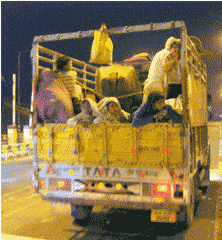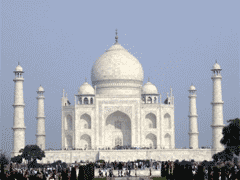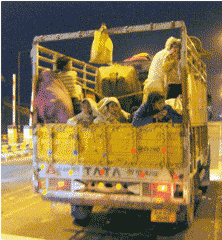Today Agra – Tomorrow Hong Kong: Flow with the Cultures and the Centuries.
- SUBSCRIBE
- ALREADY SUBSCRIBED?
BECOME A BONJOUR PARIS MEMBER
Gain full access to our collection of over 5,000 articles and bring the City of Light into your life. Just 60 USD per year.
Find out why you should become a member here.
Sign in
Fill in your credentials below.
We opted for a car and driver. That cost little more than the train and it let us wallow a few hours longer in the luxury of New Delhi’s Taj Mahal Hotel. The drive to Agra took over four hours (vs. 2 ½ hours by train). But when we factored in travel to and from the train station, sitting in the waiting room and arranging for storage of luggage we didn’t want for our one day in Agra, the time was about the same. Plus, with a car we’d have the option of taking roads not usually explored.
The car was great and so was the driver. But we had to share the road with a mind- boggling assortment of vehicles and beasts. Buses of all sizes, shapes and degrees of dilapidation…trucks ditto, and usually overloaded to ridiculous heights…carts pulled by camels or oxen or mules or donkeys…cars, motorcycles, scooters and bikes darting about with heart-stopping bravura…pedestrians crossing the road wherever and whenever… and, oh yes, an occasional cow or water buffalo moping along or simply lying down in the middle of traffic, confident in the knowledge they were sacred to Hindus. And this was on a toll road! When we asked our driver if all that was legal, he simply explained that it wasn’t – but “fines” paid in cash helped the police supplement their less than satisfactory incomes.
boggling assortment of vehicles and beasts. Buses of all sizes, shapes and degrees of dilapidation…trucks ditto, and usually overloaded to ridiculous heights…carts pulled by camels or oxen or mules or donkeys…cars, motorcycles, scooters and bikes darting about with heart-stopping bravura…pedestrians crossing the road wherever and whenever… and, oh yes, an occasional cow or water buffalo moping along or simply lying down in the middle of traffic, confident in the knowledge they were sacred to Hindus. And this was on a toll road! When we asked our driver if all that was legal, he simply explained that it wasn’t – but “fines” paid in cash helped the police supplement their less than satisfactory incomes.
We made one rest stop – in the town of Mathura, which happens to be the birthplace of Krishna, one of India’s major deities. There is a large (and painfully gaudy) temple to him there, and the road to it was flanked by the usual array of souvenir shoplets, as well as animals large and small. Amid the visual cacophony there was one symbol of order: a gaggle of schoolgirls all in identical spanking-clean uniforms (and all giggling at the unaccustomed sight of two Westerners wondering on their street.) Just next to Krishna’s shine stood a Mosque.
My husband doesn’t like to hire drivers but admitted there’s no way he’d navigate the chaos of Indian traffic. There are no rules of the road or lanes. If there are street lights or traffic signs, people ignore them. There were occasional police standing in the middle of the road waving flickering red battery-lit batons. I wonder how many per year are killed in the line of duty while futility attempting to direct cars (and any and all other forms of transport) from here to there.
There wasn’t too much to see at the sides of the road. An occasional small temple, clumps of tiny stores apparently all selling the same things, a few factories, fields of sugar cane and safflower plants (where there was water for irrigation) and stretches of scrubby desert (where there wasn’t).  Rajasthan gets rain in torrents for a month or so in summer, and that’s about it. Ground water is either absent altogether or so deep (3000 feet down or more) that drilling artesian wells is impractical. In a country where millions go hungry and the land reminded us of Provence, we saw no fig trees, grape vines, olive trees or other draught-resistant crops. We did drink a more than decent Indian Shiraz but it must have been from another part of the country.
Rajasthan gets rain in torrents for a month or so in summer, and that’s about it. Ground water is either absent altogether or so deep (3000 feet down or more) that drilling artesian wells is impractical. In a country where millions go hungry and the land reminded us of Provence, we saw no fig trees, grape vines, olive trees or other draught-resistant crops. We did drink a more than decent Indian Shiraz but it must have been from another part of the country.
When we finally got to Agra we were rewarded: our hotel (the Oberoi Amervilas) was stunning – built a few years ago but in the traditional Rajasthan style, long and low with lots of cupolas, pavilions and terraces – all in calm beige sandstone. As in so many luxury hotels in Asia, there was service staff galore, well trained and courteous to a fault. My husband who likes spicy food thought the meals were great. I instead had to stick to yoghurt and steamed rice – about the only things on the menu that didn’t send my stomach into convulsions.
Hotel rooms were large and supremely comfortable. There was complementary fruit and beverages waiting for us when we arrived and replenished the next day. Though the hotel was full – November is high season in India – the whole place is so spacious and well thought out that we felt as we were practically the only ones there. In the evening the hotel’s guests were treated to a concert of classical Indian dance on the roof of the pool pavilion (every room faced toward it and the Olympic-size heated pool.
This hotel has something more and no one can take it away. It has a bird’s eye view of the real Taj Mahal. Everywhere you go in the hotel takes your breath away. The adage, “location, location, location has no truer meaning than here.
Lovely as the hotel was, the major reward of our trip was the Taj Mahal (“great stone” in Hindi) itself. It was built as the tomb of a 16th century Moghul emperor’s beloved wife (the third one – the other wives were buried in more modest circumstances.) It’s an amazing building – all in white marble decorated with semi-precious stone inlays forming traceries of vines and flowers.
The scale of the building is impressive: from the paved terrace to top of the principal dome it’s about 250 feet, and there are minarets and gates and secondary domes, all in perfect symmetry. The main architect was imported from Persia, as were many of the stonemasons and inlay artists.
We could see it looming large over the city from our hotel room. The sight was made even more romantic by the pollution haze that hovers over Agra. In fact, for the final leg of our drive to the Taj Mahal we had to change from our diesel car to an electric golf cart – the only vehicles allowed to come near it, to help cut down pollution damage to the building.
The Taj Mahal is more than a great building – it’s now the main raison d’etre of the city of Agra with its over one million inhabitants. Agra was once the capital of Rajasthan, but now its economic life depends directly or indirectly from Taj Mahal and the millions of tourists who come to see it each year (foreigners pay an admission fee of 750 rupees each – about $16 dollars). The city produces and sells the stuff that tourists tend to buy there – textiles, jewelry and handicrafts (especially table tops, boxes and other objects of inlaid marble usually made by descendents of the artisans who built the Taj Mahal.)
We left the following morning for our tedious drive to Delhi’s airport and  our evening flight to Hong Kong, replete with India’s sights and sounds: its sumptuous monuments and teeming markets, the luxury hotels and stores – and the insistent but never threatening children or young mothers who tapped on our car windows or followed us around when we walked, hoping for a handout (which we had been warned over and over not to give, lest we find ourselves surrounded by other needy hands.)
our evening flight to Hong Kong, replete with India’s sights and sounds: its sumptuous monuments and teeming markets, the luxury hotels and stores – and the insistent but never threatening children or young mothers who tapped on our car windows or followed us around when we walked, hoping for a handout (which we had been warned over and over not to give, lest we find ourselves surrounded by other needy hands.)
As we were told by friends who lived in India for some months, and came back to Paris entranced by their time there, “India is a life-changing experience.” They were right.




